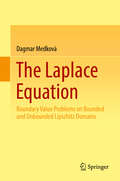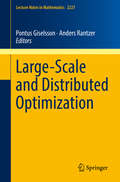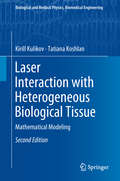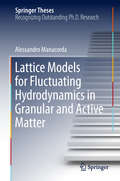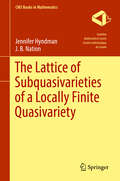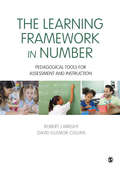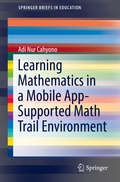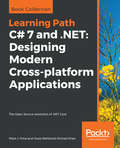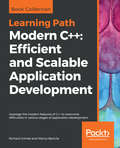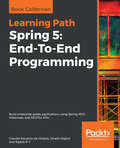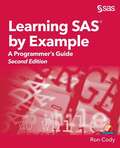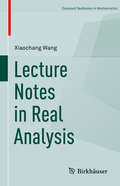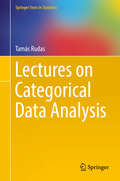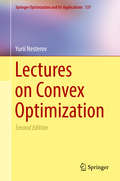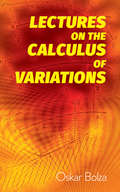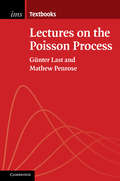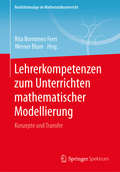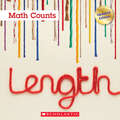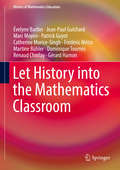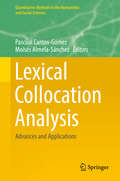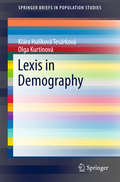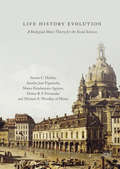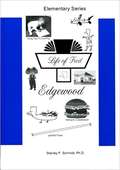- Table View
- List View
The Laplace Equation
by Dagmar MedkováThis book is devoted to boundary value problems of the Laplace equation on bounded and unbounded Lipschitz domains. It studies the Dirichlet problem, the Neumann problem, the Robin problem, the derivative oblique problem, the transmission problem, the skip problem and mixed problems. It also examines different solutions - classical, in Sobolev spaces, in Besov spaces, in homogeneous Sobolev spaces and in the sense of non-tangential limit. It also explains relations between different solutions. The book has been written in a way that makes it as readable as possible for a wide mathematical audience, and includes all the fundamental definitions and propositions from other fields of mathematics. This book is of interest to research students, as well as experts in partial differential equations and numerical analysis.
Large-Scale and Distributed Optimization (Lecture Notes in Mathematics #2227)
by Pontus Giselsson Anders RantzerThis book presents tools and methods for large-scale and distributed optimization. Since many methods in "Big Data" fields rely on solving large-scale optimization problems, often in distributed fashion, this topic has over the last decade emerged to become very important. As well as specific coverage of this active research field, the book serves as a powerful source of information for practitioners as well as theoreticians.Large-Scale and Distributed Optimization is a unique combination of contributions from leading experts in the field, who were speakers at the LCCC Focus Period on Large-Scale and Distributed Optimization, held in Lund, 14th–16th June 2017. A source of information and innovative ideas for current and future research, this book will appeal to researchers, academics, and students who are interested in large-scale optimization.
Laser Interaction with Heterogeneous Biological Tissue: Mathematical Modeling (Biological and Medical Physics, Biomedical Engineering)
by Kirill Kulikov Tatiana KoshlanThis book introduces readers to the principles of laser interaction with biological cells and tissues with varying degrees of organization. In addition to considering the problems of biomedical cell diagnostics, and modeling the scattering of laser irradiation of blood cells for biological structures (dermis, epidermis, vascular plexus), it presents an analytic theory based on solving the wave equation for the electromagnetic field. It discusses a range of mathematical modeling topics, including optical characterization of biological tissue with large-scale and small-scale inhomogeneities in the layers; heating blood vessels using laser irradiation on the outer surface of the skin; and thermo-chemical denaturation of biological structures based on the example of human skin. In this second edition, a new electrodynamic model of the interaction of laser radiation with blood cells is presented for the structure of cells and the in vitro prediction of optical properties. The approach developed makes it possible to determine changes in cell size as well as modifications in their internal structures, such as transformation and polymorphism nucleus scattering, which is of interest for cytological studies. The new model is subsequently used to calculate the size distribution function of irregular-shape particles with a variety of forms and structures, which allows a cytological analysis of the observed deviations from normal cells.
Lattice Models for Fluctuating Hydrodynamics in Granular and Active Matter (Springer Theses)
by Alessandro ManacordaThis book investigates the common nature of granular and active systems, which is rooted in their intrinsic out-of-equilibrium behavior, with the aim of finding minimal models able to reproduce and predict the complex collective behavior observed in experiments and simulations. Granular and active matter are among the most studied systems in out-of-equilibrium statistical physics. The book guides readers through the derivation of a fluctuating hydrodynamic description of granular and active matter by means of controlled and transparent mathematical assumptions made on a lattice model. It also shows how a macroscopic description can be provided from microscopic requirements, leading to the prediction of collective states such as cooling, swarming, clustering and the transitions among them. The analytical and numerical results shed new light on the physical connection between the local, microscopic properties of few particles and the macroscopic collective motion of the whole system.
The Lattice of Subquasivarieties of a Locally Finite Quasivariety (CMS Books in Mathematics)
by Jennifer Hyndman J. B. NationThis book discusses the ways in which the algebras in a locally finite quasivariety determine its lattice of subquasivarieties. The book starts with a clear and comprehensive presentation of the basic structure theory of quasivariety lattices, and then develops new methods and algorithms for their analysis. Particular attention is paid to the role of quasicritical algebras. The methods are illustrated by applying them to quasivarieties of abelian groups, modular lattices, unary algebras and pure relational structures. An appendix gives an overview of the theory of quasivarieties. Extensive references to the literature are provided throughout.
The Learning Framework in Number: Pedagogical Tools for Assessment and Instruction (Math Recovery)
by Robert J Wright David Ellemor-CollinsThis book is borne out of a collaborative research project (2004-8) between Math Recovery and CEM (Catholic Education Melbourne) funded by the Australian Research Council focusing on intervention in the number learning of low-attaining students in the first five years of school. This has involved developing new pedagogical tools (PTs) for assessment, instruction and intervention including a coherent, research-based framework for understanding the key aspects of students’ developing number knowledge. It also offers guidance on innovative video-based assessment and an overview of principles of intervention instruction. This book will be a useful guide for all primary and elementary school classroom teachers and assistants, and specialist teachers, including experienced Mathematics Recovery instructors. It will also be of significant interest to teacher educators and researchers.
The Learning Framework in Number: Pedagogical Tools for Assessment and Instruction (Math Recovery)
by Robert J Wright David Ellemor-CollinsThis book is borne out of a collaborative research project (2004-8) between Math Recovery and CEM (Catholic Education Melbourne) funded by the Australian Research Council focusing on intervention in the number learning of low-attaining students in the first five years of school. This has involved developing new pedagogical tools (PTs) for assessment, instruction and intervention including a coherent, research-based framework for understanding the key aspects of students’ developing number knowledge. It also offers guidance on innovative video-based assessment and an overview of principles of intervention instruction. This book will be a useful guide for all primary and elementary school classroom teachers and assistants, and specialist teachers, including experienced Mathematics Recovery instructors. It will also be of significant interest to teacher educators and researchers.
Learning Mathematics in a Mobile App-Supported Math Trail Environment (SpringerBriefs in Education)
by Adi Nur CahyonoThis brief presents the results of a study on the development of the mobile app-supported math trail program for learning mathematics. This study is a part of the MathCityMap-Project, a project of the MATIS I Team from IDMI Goethe-Universität Frankfurt, Germany, that comprises math trails around the city that are supported by the use of GPS-enabled mobile phone technology. The project offers an activity that is designed to support students in constructing their own mathematical knowledge by solving the prepared mathematical tasks on the math trail and interacting with the environment, including the digital environment. The brief focuses specifically on the development of a model for a mobile app-supported math trail programme and the implementation of this programme in Indonesia. It offers both an empirical exploration of its implementation as well as critical assessment of students’ motivation in mathematics, their own performance, as well as teachers’ mathematics beliefs. It concludes with a future-forward perspective by recommending strategies for implementation in schools, among the general public of the existing math trails (including its supporting tool). It also discusses strategies for developing and designing new trails and suggests further research in other geographical regions and contexts for continued project development and implementation. Learning Mathematics in a Mobile App-Supported Math Trail Environment articulates an innovative and exciting future for integrating real mathematical tasks and geographic and digital environment into effective mathematics education.
Learning Path - C# 7 and .NET: The Open Source Revolution Of . Net Core
by Ovais Mehboob Khan Mark J. PriceThis Learning Path is designed for developers who want to gain a solid foundation with C# and .NET Core, and want to build cross-platform applications. To gain maximum benefits from this Learning Path, you must have the basic knowledge of C#.
Learning Path - Modern C++: Efficient and Scalable Application Development
by Marius Bancila Richard GrimesThis Learning Path is designed for developers who want to gain a solid foundation with C++. A computer, an Internet connection, and the desire to learn how to code in C++ are all you need to get started with this Learning Path.
Learning Path - Spring 5: End to End Programming
by Rajesh R V Dinesh Rajput Claudio Eduardo OliveiraIf you're a developer starting out with Spring, then this learning path will help you learn about the new Spring 5.0 framework concepts followed by their implementation in Java and Kotlin. If you are an experienced Spring developer, then this Learning Path will enable you to gain insights into the new features added in Spring 5.0.
Learning SAS by Example: A Programmer's Guide
by Ron CodyLearn to program SAS by example! Learning SAS by Example: A Programmer’s Guide, Second Edition, teaches SAS programming from very basic concepts to more advanced topics. Because most programmers prefer examples rather than reference-type syntax, this book uses short examples to explain each topic. The second edition has brought this classic book on SAS programming up to the latest SAS version, with new chapters that cover topics such as PROC SGPLOT and Perl regular expressions. This book belongs on the shelf (or e-book reader) of anyone who programs in SAS, from those with little programming experience who want to learn SAS to intermediate and even advanced SAS programmers who want to learn new techniques or identify new ways to accomplish existing tasks. <P><P>In an instructive and conversational tone, author Ron Cody clearly explains each programming technique and then illustrates it with one or more real-life examples, followed by a detailed description of how the program works. The text is divided into four major sections: Getting Started, DATA Step Processing, Presenting and Summarizing Your Data, and Advanced Topics. Subjects addressed include
Lecture Notes in Real Analysis (Compact Textbooks in Mathematics)
by Xiaochang WangThis compact textbook is a collection of the author’s lecture notes for a two-semester graduate-level real analysis course. While the material covered is standard, the author’s approach is unique in that it combines elements from both Royden’s and Folland’s classic texts to provide a more concise and intuitive presentation. Illustrations, examples, and exercises are included that present Lebesgue integrals, measure theory, and topological spaces in an original and more accessible way, making difficult concepts easier for students to understand. This text can be used as a supplementary resource or for individual study.
Lectures on Categorical Data Analysis
by Tamás RudasThis book offers a relatively self-contained presentation of the fundamental results in categorical data analysis, which plays a central role among the statistical techniques applied in the social, political and behavioral sciences, as well as in marketing and medical and biological research. The methods applied are mainly aimed at understanding the structure of associations among variables and the effects of other variables on these interactions. A great advantage of studying categorical data analysis is that many concepts in statistics become transparent when discussed in a categorical data context, and, in many places, the book takes this opportunity to comment on general principles and methods in statistics, addressing not only the “how” but also the “why.” Assuming minimal background in calculus, linear algebra, probability theory and statistics, the book is designed to be used in upper-undergraduate and graduate-level courses in the field and in more general statistical methodology courses, as well as a self-study resource for researchers and professionals. The book covers such key issues as: higher order interactions among categorical variables; the use of the delta-method to correctly determine asymptotic standard errors for complex quantities reported in surveys; the fundamentals of the main theories of causal analysis based on observational data; the usefulness of the odds ratio as a measure of association; and a detailed discussion of log-linear models, including graphical models. The book contains over 200 problems, many of which may also be used as starting points for undergraduate research projects. The material can be used by students toward a variety of goals, depending on the degree of theory or application desired.
Lectures on Convex Optimization: A Basic Course (Springer Optimization and Its Applications #137)
by Yurii NesterovThis book provides a comprehensive, modern introduction to convex optimization, a field that is becoming increasingly important in applied mathematics, economics and finance, engineering, and computer science, notably in data science and machine learning. Written by a leading expert in the field, this book includes recent advances in the algorithmic theory of convex optimization, naturally complementing the existing literature. It contains a unified and rigorous presentation of the acceleration techniques for minimization schemes of first- and second-order. It provides readers with a full treatment of the smoothing technique, which has tremendously extended the abilities of gradient-type methods. Several powerful approaches in structural optimization, including optimization in relative scale and polynomial-time interior-point methods, are also discussed in detail. Researchers in theoretical optimization as well as professionals working on optimization problems will find this book very useful. It presents many successful examples of how to develop very fast specialized minimization algorithms. Based on the author’s lectures, it can naturally serve as the basis for introductory and advanced courses in convex optimization for students in engineering, economics, computer science and mathematics.
Lectures on Logarithmic Algebraic Geometry (Cambridge Studies in Advanced Mathematics #178)
by Arthur OgusThis graduate textbook offers a self-contained introduction to the concepts and techniques of logarithmic geometry, a key tool for analyzing compactification and degeneration in algebraic geometry and number theory. It features a systematic exposition of the foundations of the field, from the basic results on convex geometry and commutative monoids to the theory of logarithmic schemes and their de Rham and Betti cohomology. The book will be of use to graduate students and researchers working in algebraic, analytic, and arithmetic geometry as well as related fields.
Lectures on the Calculus of Variations (Dover Books on Mathematics)
by Oskar BolzaThis pioneering modern treatise on the calculus of variations studies the evolution of the subject from Euler to Hilbert. The text addresses basic problems with sufficient generality and rigor to offer a sound introduction for serious study. It provides clear definitions of the fundamental concepts, sharp formulations of the problems, and rigorous demonstrations of their solutions. Many examples are solved completely, and systematic references are given for each theorem upon its first appearance. Initial chapters address the first and second variation of the integral, and succeeding chapters cover the sufficient conditions for an extremum of the integral and Weierstrass's theory of the problem in parameter-representation; Kneser's extension of Weierstrass's theory to cover the case of variable end-points; and Weierstrass's theory of the isoperimetric problems. The final chapter presents a thorough proof of Hilbert's existence theorem.
Lectures on the Poisson Process (Institute of Mathematical Statistics Textbooks #7)
by Mathew Penrose Günter LastThe Poisson process, a core object in modern probability, enjoys a richer theory than is sometimes appreciated. This volume develops the theory in the setting of a general abstract measure space, establishing basic results and properties as well as certain advanced topics in the stochastic analysis of the Poisson process. Also discussed are applications and related topics in stochastic geometry, including stationary point processes, the Boolean model, the Gilbert graph, stable allocations, and hyperplane processes. Comprehensive, rigorous, and self-contained, this text is ideal for graduate courses or for self-study, with a substantial number of exercises for each chapter. Mathematical prerequisites, mainly a sound knowledge of measure-theoretic probability, are kept in the background, but are reviewed comprehensively in the appendix. The authors are well-known researchers in probability theory; especially stochastic geometry. Their approach is informed both by their research and by their extensive experience in teaching at undergraduate and graduate levels.
Lehrerkompetenzen zum Unterrichten mathematischer Modellierung: Konzepte und Transfer (Realitätsbezüge im Mathematikunterricht)
by Rita Borromeo Ferri Werner BlumIm vorliegenden Band wird verdeutlicht, welche Kompetenzen Lehrkräfte haben sollten, um Schülerinnen und Schülern im Unterricht mathematisches Modellieren zu vermitteln. Im ersten Teil des Buches liegt der Fokus auf den zum Unterrichten von Modellierung in der Schule nötigen Lehrerkompetenzen. Dabei werden auch Möglichkeiten zur Förderung solcher Kompetenzen aufgezeigt. Im zweiten Teil des Buches stehen Konzepte für die Lehreraus- und -fortbildung im Vordergrund, die angehenden und praktizierenden Lehrkräften jene Kompetenzen vermitteln können. Lehrende in Schule und Hochschule wie auch Studierende des Lehramts finden in diesem Buch zahlreiche Anregungen aus Forschung und Praxis zu Lehrerkompetenzen in Bezug auf Modellieren und zu deren Erwerb.
Length (Math Counts: Updated Editions)
by Henry PluckroseAn introduction to capacity for the youngest readers!Math Counts series introduces young readers (grades K-3) to early math concepts. Real-world examples and corresponding photos make math concepts easy to grasp.We use the word length to describe the measurement of something from one end to the other.
Let History into the Mathematics Classroom
by Évelyne Barbin Jean-Paul Guichard Marc Moyon Patrick Guyot Catherine Morice-Singh Frédéric Métin Martine Bühler Dominique Tournès Renaud Chorlay Gérard HamonThis book brings together 10 experiments which introduce historical perspectives into mathematics classrooms for 11 to 18-year-olds. The authors suggest that students should not only read ancient texts, but also should construct, draw and manipulate. The different chapters refer to ancient Greek, Indian, Chinese and Arabic mathematics as well as to contemporary mathematics. Students are introduced to well-known mathematicians--such as Gottfried Leibniz and Leonard Euler--as well as to less famous practitioners and engineers. Always, there is the attempt to associate the experiments with their scientific and cultural contexts. One of the main values of history is to show that the notions and concepts we teach were invented to solve problems. The different chapters of this collection all have, as their starting points, historic problems--mathematical or not. These are problems of exchanging and sharing, of dividing figures and volumes as well as engineers' problems, calculations, equations and congruence. The mathematical reasoning which accompanies these actions is illustrated by the use of drawings, folding, graphical constructions and the production of machines.
Lexical Collocation Analysis: Advances and Applications (Quantitative Methods in the Humanities and Social Sciences)
by Pascual Cantos-Gómez Moisés Almela-SánchezThis book re-examines the notion of word associations, more precisely collocations. It attempts to come to a potentially more generally applicable definition of collocation and how to best extract, identify and measure collocations. The book highlights the role played by (i) automatic linguistic annotation (part-of-speech tagging, syntactic parsing, etc.), (ii) using semantic criteria to facilitate the identification of collocations, (iii) multi-word structured, instead of the widespread assumption of bipartite collocational structures, for capturing the intricacies of the phenomenon of syntagmatic attraction, (iv) considering collocation and valency as near neighbours in the lexis-grammar continuum and (v) the mathematical properties of statistical association measures in the automatic extraction of collocations from corpora. This book is an ideal guide to the use of statistics in collocation analysis and lexicography, as well as a practical text to the development of skills in the application of computational lexicography. Lexical Collocation Analysis: Advances and Applications begins with a proposal for integrating both collocational and valency phenomena within the overarching theoretical framework of construction grammar. Next the book makes the case for integrating advances in syntactic parsing and in collocational analysis. Chapter 3 offers an innovative look at complementing corpus data and dictionaries in the identification of specific types of collocations consisting of restricted predicate-argument combinations. This strategy complements corpus collocational data with network analysis techniques applied to dictionary entries. Chapter 4 explains the potential of collocational graphs and networks both as a visualization tool and as an analytical technique. Chapter 5 introduces MERGE (Multi-word Expressions from the Recursive Grouping of Elements), a data-driven approach to the identification and extraction of multi-word expressions from corpora. Finally the book concludes with an analysis and evaluation of factors influencing the performance of collocation extraction methods in parsed corpora.
Lexis in Demography
by Klára Hulíková Tesárková Olga KurtinováThis book explores the life of economist and social scientist Wilhelm Lexis and the key demographic instrument named after him: the Lexis diagram. It describes this vital tool, which helps demographers visualize data, and examines its various forms through a specially designed example. As a result, readers get to see the Lexis diagram in practice and gain first-hand insight into its different forms.The authors first present a brief description of the life of W. Lexis with information about his childhood, studies, and work. Coverage details the places closely related to him as well as his working positions. It also lists and characterizes his publications.The book then goes on to summarize and describe the chronological development of the Lexis diagram, from initial developments through the specific contributions of W. Lexis to the refinements of those who followed. Throughout, it clearly describes as well as graphically and practically illustrates all the different versions of the diagram covered.Next, readers are presented with contemporary practical applications, including: Statistical Analysis System (SAS), R, and Stata software as well as selected key-studies from demographic, epidemiologic, and migration research.The Lexis diagram is an essential tool for working correctly with demographic data. This book commemorates the man who helped to develop these diagrams and his unquestionable influence on demography. It also provides readers with deep knowledge and insights into this basic, yet important, tool.
Life History Evolution: A Biological Meta-Theory for the Social Sciences
by Steven C. Hertler Aurelio José Figueredo Mateo Peñaherrera-Aguirre Heitor B. Fernandes Michael A. Woodley of MenieThe social sciences share a mission to shed light on human nature and society. However, there is no widely accepted meta-theory; no foundation from which variables can be linked, causally sequenced, or ultimately explained. This book advances “life history evolution” as the missing meta-theory for the social sciences. Originally a biological theory for the variation between species, research on life history evolution now encompasses psychological and sociological variation within the human species that has long been the stock and trade of social scientific study. The eighteen chapters of this book review six disciplines, eighteen authors, and eighty-two volumes published between 1734 and 2015—re-reading the texts in the light of life history evolution.
Life Of Fred: Edgewood
by Stanley F. SchmidtThe idea behind Life of Fred is that if students have an enjoyable experience and have fun doing their math, they will remember it and use it and have a good taste in their math about the whole subject. The sub-title on each of his math books is "As Serious As it Needs to Be". And that is just the point: math doesn't need to be horrid and dry. This is math-just as serious as it needs to be-and I can tell you from Louisa's smiles and chuckles, that's not very serious at all! As a bonus, these books are very low priced compared to any other math books on the market. (Compare to Saxon at 50-70). If you have a creative child who is languishing on traditional math programs, try Life of Fred! Math, As Serious As it Needs to Be! If you know your math facts (addition and multiplication) and you can read well, then the next step is to get to know Fred! <P><P> Beware: This is not a traditional math book. This is a child-directed course. The student reads the adventure story, does the math problems that occur as a natural part of the story, and checks their answers (the solutions are right there for the looking.) And learns to love math in the process! You will not get the detailed formula explanations that you get in a traditional math book. I am still amazed that kids can read the story and learn the concepts, but they do!
